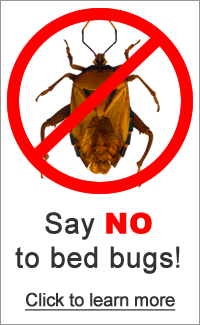Bed Bug Extermination & Control
Bed Bug incidences are on the rise in Central Ohio. The findings have become so wide spread that in October 2008, the Franklin County Health Department formed an inter-agency task force to address the issue (Columbus Bed Bug Task Force). Participants range from Pest Control Companies to Health, Code Enforcement and Housing Agencies. As a Pest Control Company involved with this effort, we support and adhere to an integrated Pest Management approach toward solving Bed bug problems. Our methods include; education, sanitation, non chemical and chemical treatments, vapor steam applications, mattress encasements, exclusion, and detection methods by utilizing trained, Certified Bed Bug Scent Detection dogs.

The foundation of our initiative is best described by the frame work authored by Dr. Susan Jones, of the Ohio State University Department of Entomology.
Bed bugs are excellent hitchhikers that can be easily transported in furniture, personal items, luggage, bedding, etc. They are most commonly found in dwellings with a high rate of occupant turnover, such as hotels, hostels, dormitories, apartment complexes, movie theaters, as well as private dwellings. They can infest airplanes, ships, trains, and buses. Bed bugs will hide in mattresses and box springs, bed frames, dressers, upholstered furniture and other furniture, cracks and crevices, electrical outlets, carpet tack strips, baseboards, window and door casings, drapery pleats, wall hangings, ceiling moldings, seams in wallpaper, etc. Bed bugs prefer to contact fabric, wood, and paper surfaces--all of which are common in human dwellings.
The pesticides and other treatments that are effective against pests such as cockroaches are not necessarily effective against bed bugs. For example, boric acid kills cockroaches, but it is ineffective against bed bugs because it is a stomach poison that must be fed upon (remember that bed bugs only feed on blood). Some pesticides will kill bed bugs that are out in the open and if the insects are sprayed directly. However, the majority of bed bugs in an infested building are hiding and will not be killed by these contact pesticides.
Bed bugs are parasitic insects. Human blood is their preferred food, but they will also feed on rodents, bats, birds and pets, if humans are not available. Adult bed bugs are small, but visible to the naked eye. An adult bed bug is from 1/4 - 3/8 inches long and reddish brown. Bed bugs have an oval shape with a flattened body when unfed; their body becomes swollen after they have fed. The young nymph (immature) that has just hatched from the egg is less than 1/10 inches long and nearly colorless, but it becomes red after taking a blood meal. Nymphs typically are yellowish brown to reddish brown.
Bed bug bite reactions often appear as two or more bites in a row. They often occur on exposed areas of the body, such as the face, neck, arms and shoulders. Bed bug bites may resemble bite reactions caused by other insects and other medical conditions. Bed bug nymphs and adults are adept crawlers, and they hitchhike from place to place by tucking away in peoples clothing and shoes; in backpacks, purses, and briefcases; in luggage; in used furniture, mattresses, bedding, etc. Eggs that are laid on these items also can allow bed bugs to be spread from place to place. When there are multiple units in a building such as in hotels, dorms, and apartments, bed bugs can easily crawl to other units and spread beyond the site of the initial infestation. Knowing what to look for can keep you from carrying bed bugs into your home. Be on the lookout for the tell-tale signs of bed bugs when traveling, working or buying used furniture, bedding and other used items.
Attention: We also have the Certified Bed Bug Mattress Encasements available for purchase (shipped right to your door!). Call to schedule an appointment
